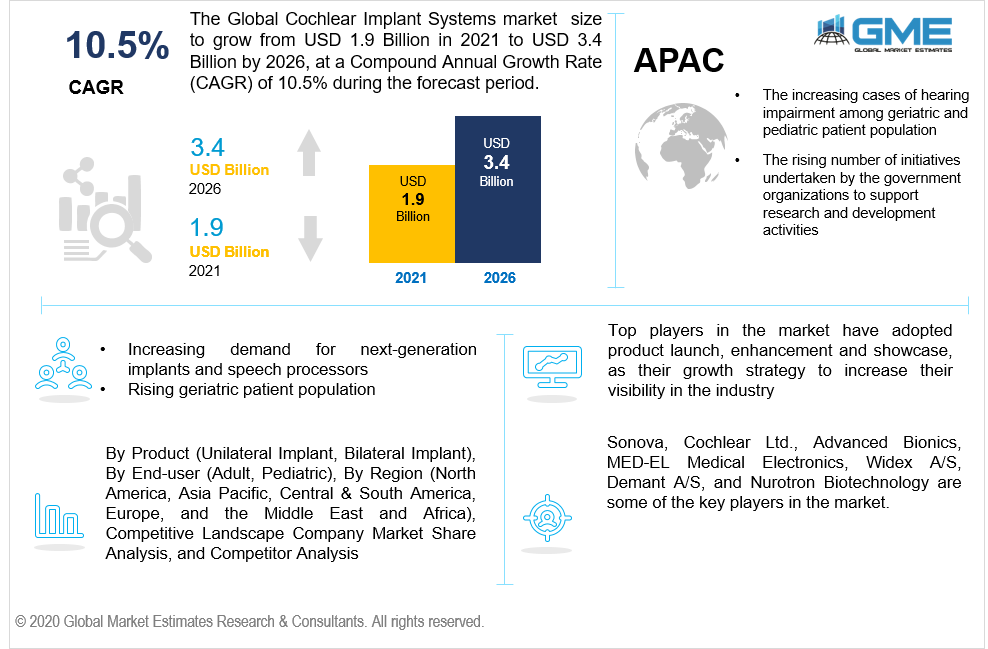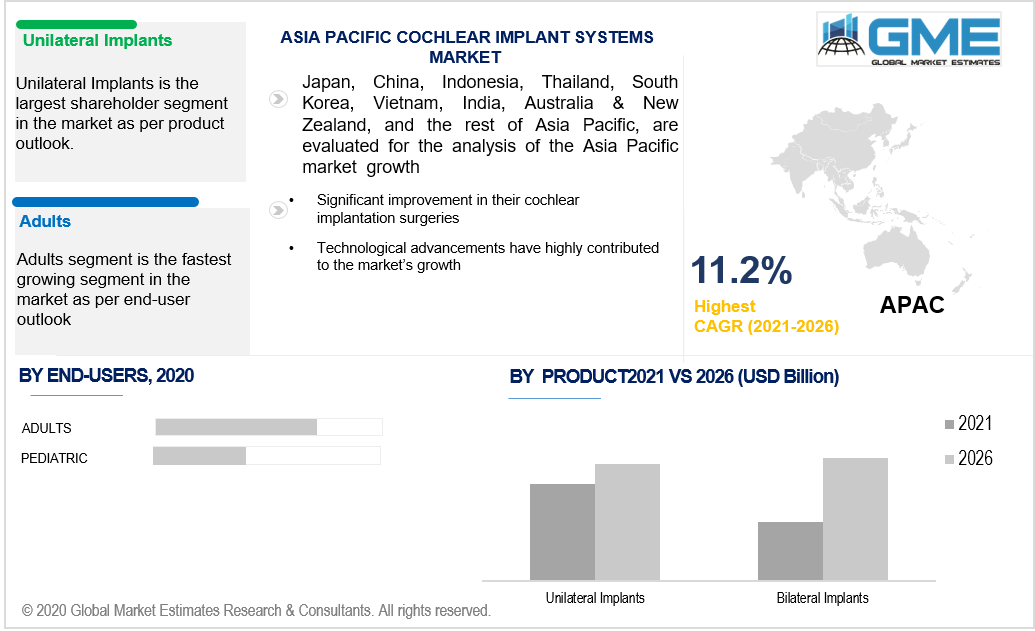
Global Cochlear Implant Systems Market Size, Trends, and Analysis - Forecasts to 2026 By Product (Unilateral Implant, Bilateral Implant), By End-user (Adult, Pediatric), By Region (North America, Asia Pacific, Central & South America, Europe, and the Middle East and Africa), Competitive Landscape, Company Market Share Analysis, and Competitor Analysis
The global cochlear implant systems market is projected to grow from USD 1.9 billion in 2021 and is analyzed to reach USD 3.4 billion by 2026 at CAGR of 10.5%.
The increasing cases of hearing impairment among geriatric and pediatric patient population across the globe, the rising number of initiatives undertaken by the government organizations to support research and development activities through funding programs and increasing number of surgical procedure for implantation are some of the drivers of the market.
Moreover, the implementation of laws and rules of funding schemes to cover these devices and the increasing demand for next-generation implants and speech processors, are supporting the growth of the market. Additionally, rising healthcare expenditure, rising number of clinical trial programs, surge in disposable income and growth in overall population will positively affect the cochlear implants market’s growth.
Cochlear implantation is the replacement of the damaged sensory cell in the inner ear by cochlear systems. Cochlear electronic devices work better than regular hearing aid machines. These not only make the voice sound louder to hear, but it also increases the clarity of the sound, enabling the person to understand the voice in a better way.
According to the World Health Organisations (WHO) reports, there are approximately 1.5 billion people across the world with some level of hearing loss. However, out of these, over 430 million people, constituting approximately 5% of the world's total population, require some hearing aid or cochlear implants. Hearing loss can be an effect of many reasons like genetic factors, birth complications, exposure to deafening noise, ear infection or infectious disease, or aging. Hearing losses experienced can differ from person to person, ranging from the mild level of to severe hearing loss deafness.
However, reports have showcased over 120,000 cases across the globe with successful stories of cochlear implant systems. The implantation of cochlear systems also has quick results and improvements in a person's ability to listen. These implants also enable the person to hear and understand the voice without lip reading or too many efforts. The cochlear implant system also enables the person to hear loud, medium, soft, and minute voices with clarity. It also helps them watch TV, hear songs, and talk on the telephone as well, the same as natural ability.
Irrespective of the encouragement and investments made by the government and other medical institutions, people in different countries still lack awareness about the benefits of cochlear implant systems. Out of the total patient population, only 17% of them actually utilize these implants. This gap between services available and services availed is witnessed due to lack of awareness amongst patients and healthcare providers.

Based on product type, the market is segmented into unilateral implant, and bilateral implant. Patients most commonly prefer unilateral implantations and hence the unilateral implant will be the largest segment in the market. Adults who suffer from hearing loss majorly use these implantations. The unilateral implant systems enable the individuals to hear normal voices and help them perceive naturally. Besides these benefits of unilateral implants, these are comparatively more cost-effective than the bilateral implant systems.

As per the geographical analysis, the market is segmented into North America, Europe, Asia Pacific, Middle East & Africa, and Central & South America. North American region dominated the cochlear implant systems market due to the increasing demand for cochlear implants and the constantly rising number of hearing loss cases in the U.S. and Canada.
However, the Asia Pacific region is one of the significant regional segments for cochlear implant systems. The Asia Pacific is analyzed to be the fastest growing regional segment in the market from 2021 to 2026. Countries like India, Japan, and many other developing and underdeveloped countries account for a larger share of geriatric/old aged people as compared to the younger generation.
Sonova, Cochlear Ltd., Advanced Bionics, MED-EL Medical Electronics, Widex A/S, Demant A/S, and Nurotron Biotechnology are some of the key players in the market.
Please note: This is not an exhaustive list of companies profiled in the report.
In December 2019, FDA sanctioned an approval to Cochlear Ltd. to launch their new cochlear Osia system for the U.S. market.
In June 2019, FDA sanctioned an approval to Advanced Bionics for Marvel Cochlear Implant Platform.
Chapter 1 Methodology
1.1 Market Scope & Definitions
1.2 Estimates & Forecast Calculation
1.3 Historical Data Overview and Validation
1.4 Data Sources
1.4.1 Secondary
1.4.2 Primary
Chapter 2 Report Outlook
2.1 Cochlear Implant Systems Industry Overview, 2020-2026
2.1.1 Industry Overview
2.1.2 Type Overview
2.1.3 End-user Overview
2.1.4 Regional Overview
Chapter 3 Cochlear Implant Systems Market Trends
3.1 Market Segmentation
3.2 Industry Background, 2020-2026
3.3 Market Key Trends
3.3.1 Positive Trends
3.3.1.1 Rising product launch strategies in the cochlear implant systems market
3.3.2 Industry Challenges
3.3.2.1 Lack of awareness regarding treatment protocol for hearing loss
3.4 Prospective Growth Scenario
3.4.1 Type Growth Scenario
3.4.2 End-user Growth Scenario
3.5 COVID-19 Influence over Industry Growth
3.6 Porter’s Analysis
3.7 PESTEL Analysis
3.8 Value Chain & Supply Chain Analysis
3.9 Regulatory Framework
3.9.1 North America
3.9.2 Europe
3.9.3 APAC
3.9.4 LATAM
3.9.5 MEA
3.10 End-user Overview
3.11 Market Share Analysis, 2020
3.11.1 Company Positioning Overview, 2020
Chapter 4 Cochlear Implant Systems Market, By Type
4.1 Type Outlook
4.2 Unilateral Implant
4.2.1 Market Size, By Region, 2020-2026 (USD Million)
4.3 Bilateral Implant
4.3.1 Market Size, By Region, 2020-2026 (USD Million)
Chapter 5 Cochlear Implant Systems Market, By End-user
5.1 End-user Outlook
5.2 Adult
5.2.1 Market Size, By Region, 2020-2026 (USD Million)
5.3 Pediatric
5.3.1 Market Size, By Region, 2020-2026 (USD Million)
Chapter 6 Cochlear Implant Systems Market, By Region
6.1 Regional outlook
6.2 North America
6.2.1 Market Size, By Country 2020-2026 (USD Million)
6.2.2 Market Size, By Type, 2020-2026 (USD Million)
6.2.3 Market Size, By End-user, 2020-2026 (USD Million)
6.2.4 U.S.
6.2.4.1 Market Size, By Type, 2020-2026 (USD Million)
6.2.4.2 Market Size, By End-user, 2020-2026 (USD Million)
6.2.5 Canada
6.2.5.1 Market Size, By Type, 2020-2026 (USD Million)
6.2.5.2 Market Size, By End-user, 2020-2026 (USD Million)
6.3 Europe
6.3.1 Market Size, By Country 2020-2026 (USD Million)
6.3.2 Market Size, By Type, 2020-2026 (USD Million)
6.3.3 Market Size, By End-user, 2020-2026 (USD Million)
6.3.4 Germany
6.3.4.1 Market Size, By Type, 2020-2026 (USD Million)
6.3.4.2 Market Size, By End-user, 2020-2026 (USD Million)
6.3.5 UK
6.3.5.1 Market Size, By Type, 2020-2026 (USD Million)
6.3.5.2 Market Size, By End-user, 2020-2026 (USD Million)
6.3.6 France
6.3.6.1 Market Size, By Type, 2020-2026 (USD Million)
6.3.6.2 Market Size, By End-user, 2020-2026 (USD Million)
6.3.7 Italy
6.3.7.1 Market Size, By Type, 2020-2026 (USD Million)
6.3.7.2 Market Size, By End-user, 2020-2026 (USD Million)
6.3.8 Spain
6.3.8.1 Market Size, By Type, 2020-2026 (USD Million)
6.3.8.2 Market Size, By End-user, 2020-2026 (USD Million)
6.3.9 Russia
6.3.9.1 Market Size, By Type, 2020-2026 (USD Million)
6.3.9.2 Market Size, By End-user, 2020-2026 (USD Million)
6.4 Asia Pacific
6.4.1 Market Size, By Country 2020-2026 (USD Million)
6.4.2 Market Size, By Type, 2020-2026 (USD Million)
6.4.3 Market Size, By End-user, 2020-2026 (USD Million)
6.4.4 China
6.4.4.1 Market Size, By Type, 2020-2026 (USD Million)
6.4.4.2 Market Size, By End-user, 2020-2026 (USD Million)
6.4.5 India
6.4.5.1 Market Size, By Type, 2020-2026 (USD Million)
6.4.5.2 Market Size, By End-user, 2020-2026 (USD Million)
6.4.6 Japan
6.4.6.1 Market Size, By Type, 2020-2026 (USD Million)
6.4.6.2 Market Size, By End-user, 2020-2026 (USD Million)
6.4.7 Australia
6.4.7.1 Market Size, By Type, 2020-2026 (USD Million)
6.4.7.2 Market size, By End-user, 2020-2026 (USD Million)
6.4.8 South Korea
6.4.8.1 Market Size, By Type, 2020-2026 (USD Million)
6.4.8.2 Market Size, By End-user, 2020-2026 (USD Million)
6.5 Latin America
6.5.1 Market Size, By Country 2020-2026 (USD Million)
6.5.2 Market Size, By Type, 2020-2026 (USD Million)
6.5.3 Market Size, By End-user, 2020-2026 (USD Million)
6.5.4 Brazil
6.5.4.1 Market Size, By Type, 2020-2026 (USD Million)
6.5.4.2 Market Size, By End-user, 2020-2026 (USD Million)
6.5.5 Mexico
6.5.5.1 Market Size, By Type, 2020-2026 (USD Million)
6.5.5.2 Market Size, By End-user, 2020-2026 (USD Million)
6.5.6 Argentina
6.5.6.1 Market Size, By Type, 2020-2026 (USD Million)
6.5.6.2 Market Size, By End-user, 2020-2026 (USD Million)
6.6 MEA
6.6.1 Market Size, By Country 2020-2026 (USD Million)
6.6.2 Market Size, By Type, 2020-2026 (USD Million)
6.6.3 Market Size, By End-user, 2020-2026 (USD Million)
6.6.4 Saudi Arabia
6.6.4.1 Market Size, By Type, 2020-2026 (USD Million)
6.6.4.2 Market Size, By End-user, 2020-2026 (USD Million)
6.6.5 UAE
6.6.5.1 Market Size, By Type, 2020-2026 (USD Million)
6.6.5.2 Market Size, By End-user, 2020-2026 (USD Million)
6.6.6 South Africa
6.6.6.1 Market Size, By Type, 2020-2026 (USD Million)
6.6.6.2 Market Size, By End-user, 2020-2026 (USD Million)
Chapter 7 Company Landscape
7.1 Competitive Analysis, 2020
7.2 Sonova
7.2.1 Company Overview
7.2.2 Financial Analysis
7.2.3 Strategic Positioning
7.2.4 Info Graphic Analysis
7.3 Cochlear Ltd.
7.3.1 Company Overview
7.3.2 Financial Analysis
7.3.3 Strategic Positioning
7.3.4 Info Graphic Analysis
7.4 Advanced Bionics
7.4.1 Company Overview
7.4.2 Financial Analysis
7.4.3 Strategic Positioning
7.4.4 Info Graphic Analysis
7.5 MED-EL Medical Electronics
7.5.1 Company Overview
7.5.2 Financial Analysis
7.5.3 Strategic Positioning
7.5.4 Info Graphic Analysis
7.6 Widex A/S
7.6.1 Company Overview
7.6.2 Financial Analysis
7.6.3 Strategic Positioning
7.6.4 Info Graphic Analysis
7.7 Demant A/S
7.7.1 Company Overview
7.7.2 Financial Analysis
7.7.3 Strategic Positioning
7.7.4 Info Graphic Analysis
7.8 Nurotron Biotechnology
7.8.1 Company Overview
7.8.2 Financial Analysis
7.8.3 Strategic Positioning
7.8.4 Info Graphic Analysis
7.9 Others
7.9.1 Company Overview
7.9.2 Financial Analysis
7.9.3 Strategic Positioning
7.9.4 Info Graphic Analysis
The Global Cochlear Implant Systems Market has been studied from the year 2019 till 2026. However, the CAGR provided in the report is from the year 2021 to 2026. The research methodology involved three stages: Desk research, Primary research, and Analysis & Output from the entire research process.

The desk research involved a robust background study which meant referring to paid and unpaid databases to understand the market dynamics; mapping contracts from press releases; identifying the key players in the market, studying their product portfolio, competition level, annual reports/SEC filings & investor presentations; and learning the demand and supply-side analysis for the Cochlear Implant Systems Market.

The primary research activity included telephonic conversations with more than 50 tier 1 industry consultants, distributors, and end-use product manufacturers.

Finally, based on the above thorough research process, an in-depth analysis was carried out considering the following aspects: market attractiveness, current & future market trends, market share analysis, SWOT analysis of the company and customer analytics.

Frequently Asked Questions
Tailor made solutions just for you
80% of our clients seek made-to-order reports. How do you want us to tailor yours?
OUR CLIENTS